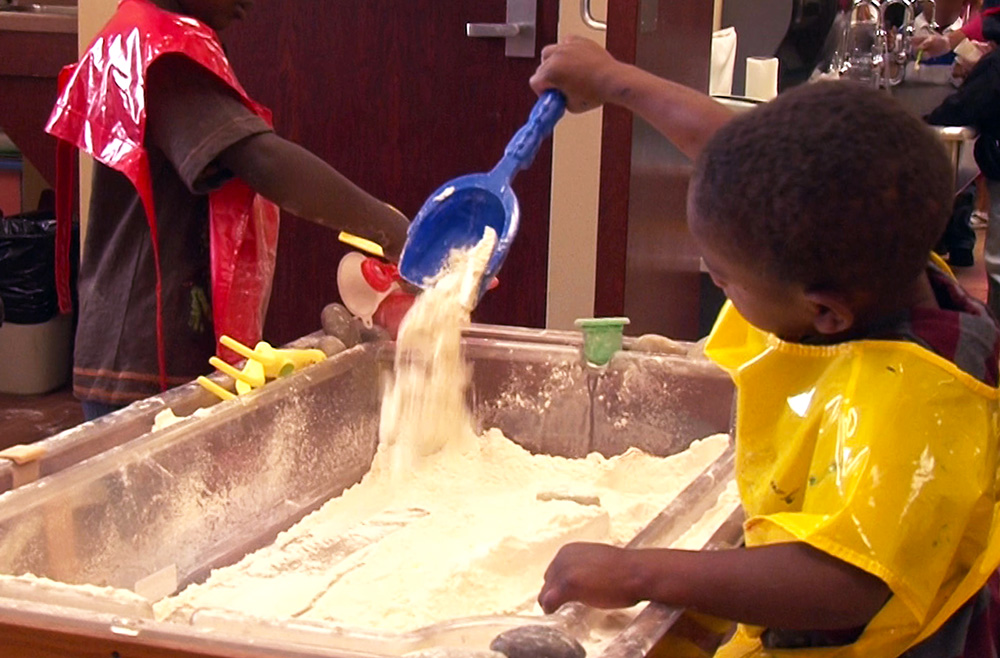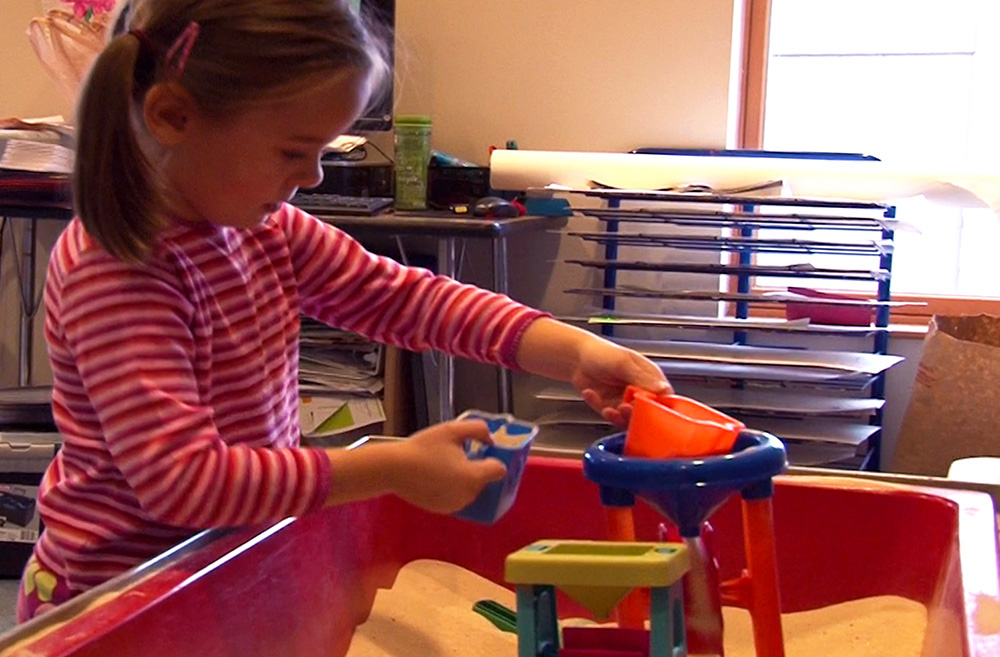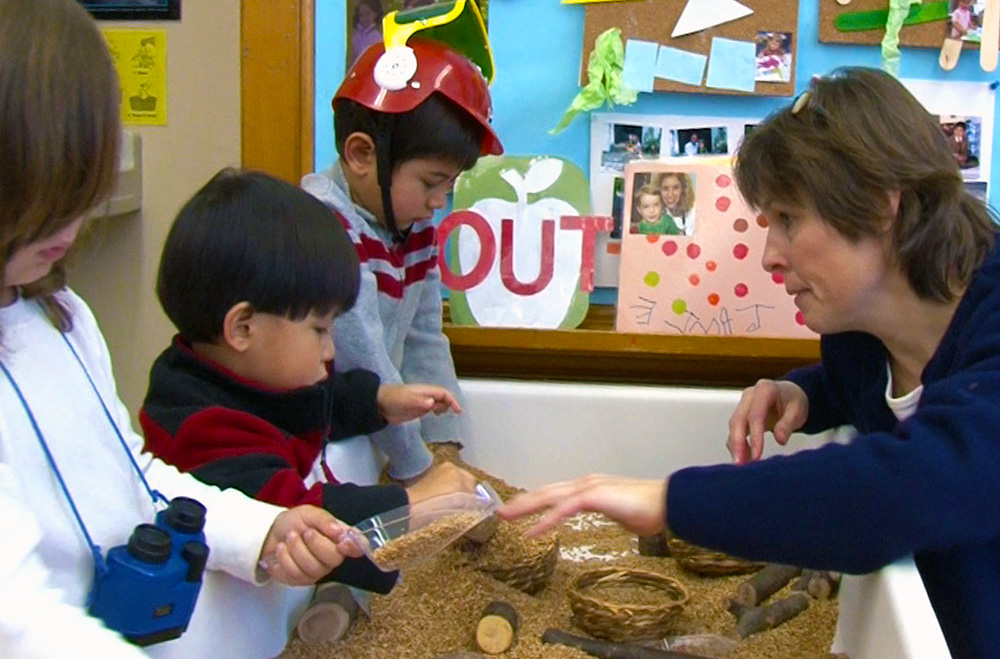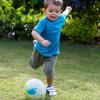- List examples of ways you can support children’s physical development indoors.
- Explore resources that provide information on supporting the physical development of all children in your classroom.
- Identify accommodations that will support the physical development of all children in your classroom.
Learn
Know
The preschool years are considered some of the most active times in an individual’s life. You learned in Lesson One (Physical Development: An Introduction) about the significance of physical activity in young children’s lives. Preschool children need time for movement and active play. Active play also provides ample opportunities for children to interact and develop connections, which contribute to language and social development. While children are engaged in active play, you have numerous opportunities to observe them and gather valuable information about their development.
Your program should provide children with plenty of opportunities to engage in physical activity. Preschoolers should engage in physical activity, whether indoors or outdoors, for at least 3 hours each day. Your program should strive to provide daily movement activities in which children are not sedentary, and where they can choose vigorous physical activity or other play, such as dressing up in costumes (U.S. Department of Health and Human Services, 2018). Though 3 hours of activity is recommended for children younger than 6, the activity may be broken down into increments of 5-, 10-, 15-, or 20- minute periods throughout the day. 90 minutes could be filled with structured activities like games, while another 90 minutes may consist of unstructured activities. Many health organizations suggest that higher levels of physical activity are associated with important short- and long-term health benefits in physical, emotional, social, and cognitive domains across the life span.
Embedding Physical Activity in Your Classroom Routine
Physical activity should not be viewed as a break from your classroom routine but should be part of it! Movement allows children to release energy as they practice existing skills and learn new ones. Keep in mind children’s gross- and fine-motor skills while also considering the benefits of physical activity on children’s overall development. Consider the following examples of experiences you can offer children in your classroom:
- During center time:
Provide children with opportunities to engage in pretend play in your dress-up or dramatic play area; use blocks or other items from nature to build or balance objects in the block area; draw or write using different materials in the art or writing center; explore and manipulate various items and textures in the discovery center; listen, watch the screen, or direct the mouse in the listening center or computer center; explore different textures, scents, colors, or sizes in the sensory center. - During circle time:
Play games like Simon Says or Follow The Leader to keep children active. Review the attachment Non-Competitive Active Games below for tips to make some traditional games that are non-competitive. These games can be played indoors or outdoors. For some of these games, you may have to adjust your environment if you need more space. - During or after story time:
Encourage children to role play parts of a story or to pretend to be story characters and imitate their movements and sounds. - During snack or lunch time:
Encourage children to use utensils, practice trying to open containers, pass food around the table, serve, and clean up after themselves. - During transition time:
Ask children to walk, crawl, crabwalk, or hop to where they need to be, making sure above all that they are being safe. - During any time:
Put on some music and invite children to a dance party. Dancing requires active, constant movement. Dancing involves coordination, flexibility, and strength, and it helps increase preschoolers’ ranges of motion (National Dance Education Organization, 2011). Dancing can also help with children’s awareness of self with regard to their body and spatial awareness. Adjust the environment if you need to make more space, and encourage children to make suggestions about favorite songs or types of music. You can also arrange for “work-out time” to do simple exercises with children. These exercises like yoga and Zumba can be more fun if you incorporate music.
With a little imagination and outside-the-box thinking, you can come up with numerous fun activities to keep children active throughout the day. For example, you can set up an indoor basketball game with crumpled up newspaper “balls” that children throw into a cardboard box or any type of basket, or you can ask children to “ice skate” wearing socks on a smooth floor. While making sure children are safe at all times, there are limitless possibilities to what you can do in your classroom!
Supporting the Physical Development of All Preschoolers
Physical activity may be experienced and expressed differently by children with developmental disabilities. For these children you may have to adapt or modify your curriculum and environment, as well as classroom activities to enable them to succeed. If you are working with children with special learning needs, think about how your existing practices have enabled them to succeed. Think about busy center work, transitions from one activity to another, lunch, naptime, potty time, free play time indoors and outdoors, as well as other school events. What are some things you are doing currently that support the physical development of all children in your care during the times mentioned above?
Some children in your care may have conditions that affect their motor skills, including physical and cognitive disabilities, neurological, genetic and perceptual disorders, and attention-deficit/hyperactivity disorder. Children with an Individualized Education Program (IEP) have a specific education plan to help them meet their personal goals and objectives. In general, these children may need modifications or adaptations to the curriculum, classroom environment, and daily preschool activities. Children with physical and other developmental disabilities may have a full team of support personnel to ensure that they are fully able to access their classroom and school curriculum, activities, environments, extracurricular activities, and school events. This team may include their parents or guardian, general education teacher, special education teacher, Physical Therapist, Occupational Therapist, Speech and Language Pathologist, a school psychologist, or even a social worker.
Children with physical disabilities may have difficulties with motor planning, coordination, range of motion, and muscle strength. While some children may be able to engage in play and self-help activities with minimal support or no help at all, other children may need significant assistance and require the use of adaptive equipment or assistive technology. This could include equipment, such as wheelchairs, gait trainers or braces to enable them to move and explore their environment. Some children may also require assistive technology like communication devices that let them communicate and interact with their peers. Children with physical disabilities may also have visual, hearing, or intellectual impairments that require the use of significant supports and accommodations when it comes to daily classroom activities. You may be working with children who have low muscle tone (leading to poor balance and stability) so you will need to support their body to help them participate in motor activities. You may encounter children with attention-deficit/hyperactivity disorder who may sometimes be extremely active, impulsive, or more easily distracted, and you will need to support their safe and successful participation in your classroom and program activities.
It is important to assume an inclusive attitude when imagining and creating your classroom environment. Your facility is compliant with the Americans with Disabilities Act (ADA), so at a minimum children and families with a variety of physical needs can access your building. However, it is important to go beyond access and to make sure all children and families feel welcome and involved. The Kids Included Together (KIT), Building Blocks, and Cara’s Kit can be valuable resources for ideas on helping to support the development of all children in your classroom. The resources, from the Council for Exceptional Children Division for Early Childhood, provide practical real-world ways to help children succeed in their environments. When a child with identified disabilities enters your program, work with the disability specialists and Inclusion Action Team to make sure you and other staff members know how to support the child’s physical development. You’re not only a resource but an advocate for children in your care. Consider these quick and easy adaptations:
Identified Need: | Possible Solution: |
|---|---|
| Child has a hard time gripping or catching a ball. |
|
| Child has a hard time kicking a ball. |
|
| Child has a hard time seeing a ball. |
|
Promoting Sensory Discovery and Development in Preschool
Most people are familiar with the five senses of sight, hearing, smell, touch, and taste. However, there are two more senses, named the proprioceptive and the vestibular senses. The proprioceptive sensory receptors are found in muscles or other connective tissues inside the body. They are stimulated by movement and gravity. This sense increases body awareness and helps with motor control. The vestibular sensory receptors are found in the inner ear. They help determine the speed and direction of any movement, and help us to orient ourselves in space. All seven senses help our bodies respond to outside stimulation. The preschool environment can help all children develop their senses. This section will explore ways to help promote children’s sensory development in preschool.
Movement and exploration promote sensory development. Art and writing centers offer many opportunities for children to move and explore. When children scribble they explore through their sense of sight and their use of various art materials engages multiple senses (Dodge, Colker, & Heroman, 2002). Stickers, cotton balls, pipe cleaners, and other art materials have varying colors, sizes, textures, and scents. Different sizes of paintbrushes and different painting tools, such as sponges and rollers, create different textures.
Other learning environments engage multiple senses as well. Blocks and toys have different textures and colors. Computer programs can stimulate many senses as children listen through headphones, watch the screen, and direct the mouse. Music and movement also use multiple senses. This includes listening to music, participating in dancing, or playing instruments. Food preparation and cooking allow preschoolers to explore taste, smell, and other senses.
One piece of furniture or equipment that engages preschoolers’ sensory development is the sensory table. Sensory tables can be filled with many items, including water, rice, or even beans. Children can explore by squishing, sorting, digging, pouring, and playing freely. The items can be rotated and changed on a regular basis. If you don’t have a sensory table, you can use plastic boxes or other containers in a sensory center.

Ideas for sensory centers or tables:
- Water.
You can increase interest at the water table or center by adding food coloring or soap to the water. You can also decorate the bottom of the table or container with colored contact paper. Small toys can be added as well as fish, rocks, or items that sink and float to stimulate sensory and cognitive development. - Sand.
This can be used with or without water. Adding small sifters, cups, funnels, and colorful rocks can add to the learning. - Natural materials.
Safe seasonal plant materials are easily handled. This includes twigs, dirt, leaves, and more. - Office supplies.
Preschoolers can play with shredded paper, packing peanuts, or colored paper clips. Be sure to supervise children when playing with small objects, such as packing peanuts and paperclips, which may be choking hazards. - Classroom or household items.
Large beads and buttons, cotton balls, or kitchen utensils are items that children can explore.


When selecting materials for sensory activities, always consider the developmental needs of the children in your classroom. Establish rules for making safe choices at the sensory table or center. For example, “Sensory items stay in hands or in the table, not in mouths.” Other rules include limiting the number of people allowed at the center at one time. Adult supervision may also be required.
Preschoolers will use sensory centers to discover many concepts. Add tools or toys to vary sensory center activities. Use tongs to pick up small toys to help children strengthen fine motor skills. Sorting items by color or by attributes, like sinking and floating, introduces sorting and science concepts. Watch the second video in the Learn section of this lesson to discover how one classroom explored ice.
See
What does indoor physical activity look like in preschool? What can you do to support preschool children’s physical development indoors? What experiences and materials support physical development? There are many answers to these questions. Take a look at these videos to learn more and to see examples.
Indoor Environments and Experiences
Exploring Ice
Do
Try some of these ideas to help actively include all children in your classroom. Remember that your role is to give each child what he or she needs to be successful when necessary. Remember also that at some point, all children in your classroom will need extra help and support. Above all, get to know the children in your care well and collaborate with other individuals who know them, such as family members, therapists, or related services personnel.
Experiences and Materials
- Think safety first!
- Plan activities after considering children’s particular needs and making sure all children in your classroom have access to spaces and materials.
- While planning for activities, consider tasks that may be difficult for particular children (e.g., stringing beads) and be ready to help these children complete these tasks or ask children to work together and to help each other.
- Make sure your materials are age-appropriate for the children in your care.
- Be open-minded and think outside the box! Provide sensory-stimulating activities and materials that allow children to use multiple senses in order to learn by seeing, touching, smelling, tasting, or hearing. Some children may be particularly sensitive or responsive to different kinds of stimuli or materials, and as a preschool teacher, it is important that you are willing to explore other options.
Classroom Environment
- Make it easy to move around your classroom.
- Make changes in your classroom environment. A quiet area for play with a smaller number of materials may help an overactive child be more successful because it presents fewer choices in terms of materials or toys.
- Make adaptations in your materials, activities, or environment for children who may be sensitive to noise, light, or touch. Additional lighting in your centers may be helpful for a child with vision challenges.
Classroom Interactions
- Observe children playing and make sure that all children are included in activities.
- Model appropriate behaviors and show children how they can invite and include others in their play.
- Praise children when they include other children in their play or activities.
- Provide opportunities for children to partner with peers so they can learn from each other while at the same time also work on improving their social skills.
Consideration of Multiple Perspectives
- Get input from children’s families, related professionals who work with them, or the children themselves about things that work or don’t work.
- Help all children be independent by asking them to make choices and encouraging them to do things by themselves for themselves. At the same time, be sensitive to families’ wishes and beliefs that may reflect values that are different from your own (for example, valuing interdependence and relationship-building versus independence from a young age).
Explore
What opportunities do you currently provide in your classroom that engage children in indoor experiences that promote their physical development? In the Reflecting on My Classroom Practice activity below, list or describe experiences and materials you provide. Then jot down ideas about additional experiences or materials you can incorporate to improve your practice. Share your responses with a trainer, coach, or administrator.
It is important to offer learning experiences and activities that are appropriate, engaging and supportive of children’s learning and development across various developmental domains including cognitive, social-emotional, physical, language and literacy, and creative development. Staff working toward their CDA credential should use the CDA Indoor Fine Motor Activity Plan handout to develop an indoor fine motor learning experience from your curriculum (or a new activity you plan on implementing).
Apply
In the Resources: Promoting Physical Development for All Children activity, review the listed websites to find strategies, tools, and supports for children who need extra help with physical skills. Reflect on how you might use these in your program and share your thoughts with your trainer, coach, or administrator.
Glossary
Demonstrate
American Academy of Pediatrics, American Public Health Association, & National Resource Center for Health and Safety in Child Care and Early Education. (2019). Caring for our children: National health and safety performance standards; Guidelines for early care and education programs (4th ed.). Elk Grove Village, IL: American Academy of Pediatrics; Washington, DC: American Public Health Association. https://nrckids.org
Centers for Disease Control and Prevention. (n.d.). Benefits of physical activity. Retrieved from https://www.cdc.gov/physicalactivity/basics/pa-health/index.htm
Dodge, D. T., Colker, L. J., & Heroman, C. (2002). The Creative Curriculum for Preschool (4th ed.). Washington, DC: Teaching Strategies.
Head Start Center for Inclusion. (n.d.). http://headstartinclusion.org/
HeadStart.Gov. (2025). Supporting children with disabilities or suspected delays. https://headstart.gov/publication/supporting-children-disabilities-or-suspected-delays
Lynch, S., & Simpson, C. (2004). Sensory processing: Meeting individual needs using the seven senses. Young Exceptional Children, 7 (4), 2–9.
National Association for Sport and Physical Education. (2009). Active Start: A statement of physical activity guidelines for children from birth to age 5(2nd ed.). https://www.shapeamerica.org/standards/guidelines/activestart.aspx
National Dance Education Organization. (n.d.). Standards for dance in early childhood . https://www.ndeo.org/Portals/NDEO/Standards%20Documents/Standards_for_Dance_in_Early Childhood(1).pdf
Playworks. (2020). >Game library. Oakland, CA: Sports4Kids. https://www.playworks.org/game-library/
Trawick-Smith, J. (2014). Early childhood development: A multicultural perspective . Upper Saddle River, NJ: Pearson Education.
Turnbull, R., Turnbull, A., Shank, M., & Smith, S. J. (2004). Exceptional lives: Special education in today’s schools. Upper Saddle River, NJ: Pearson Education.


